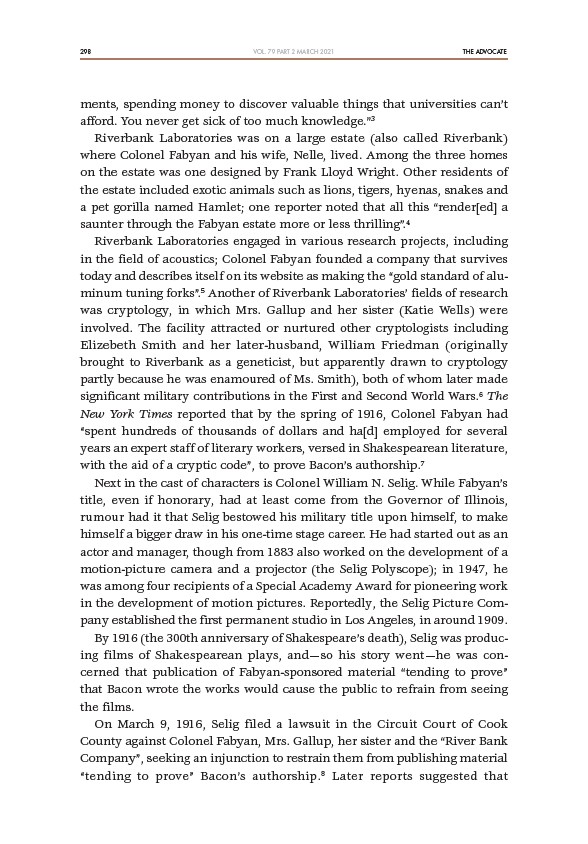
298 THE ADVOCATE
VOL. 79 PART 2 MARCH 2021
ments, spending money to discover valuable things that universities can’t
afford. You never get sick of too much knowledge.”3
Riverbank Laboratories was on a large estate (also called Riverbank)
where Colonel Fabyan and his wife, Nelle, lived. Among the three homes
on the estate was one designed by Frank Lloyd Wright. Other residents of
the estate included exotic animals such as lions, tigers, hyenas, snakes and
a pet gorilla named Hamlet; one reporter noted that all this “rendered a
saunter through the Fabyan estate more or less thrilling”.4
Riverbank Laboratories engaged in various research projects, including
in the field of acoustics; Colonel Fabyan founded a company that survives
today and describes itself on its website as making the “gold standard of aluminum
tuning forks”.5 Another of Riverbank Laboratories’ fields of research
was cryptology, in which Mrs. Gallup and her sister (Katie Wells) were
involved. The facility attracted or nurtured other cryptologists including
Elizebeth Smith and her later-husband, William Friedman (originally
brought to Riverbank as a geneticist, but apparently drawn to cryptology
partly because he was enamoured of Ms. Smith), both of whom later made
significant military contributions in the First and Second World Wars.6 The
New York Times reported that by the spring of 1916, Colonel Fabyan had
“spent hundreds of thousands of dollars and had employed for several
years an expert staff of literary workers, versed in Shakespearean literature,
with the aid of a cryptic code”, to prove Bacon’s authorship.7
Next in the cast of characters is Colonel William N. Selig. While Fabyan’s
title, even if honorary, had at least come from the Governor of Illinois,
rumour had it that Selig bestowed his military title upon himself, to make
himself a bigger draw in his one-time stage career. He had started out as an
actor and manager, though from 1883 also worked on the development of a
motion-picture camera and a projector (the Selig Polyscope); in 1947, he
was among four recipients of a Special Academy Award for pioneering work
in the development of motion pictures. Reportedly, the Selig Picture Company
established the first permanent studio in Los Angeles, in around 1909.
By 1916 (the 300th anniversary of Shakespeare’s death), Selig was producing
films of Shakespearean plays, and—so his story went—he was concerned
that publication of Fabyan-sponsored material “tending to prove”
that Bacon wrote the works would cause the public to refrain from seeing
the films.
On March 9, 1916, Selig filed a lawsuit in the Circuit Court of Cook
County against Colonel Fabyan, Mrs. Gallup, her sister and the “River Bank
Company”, seeking an injunction to restrain them from publishing material
“tending to prove” Bacon’s authorship.8 Later reports suggested that